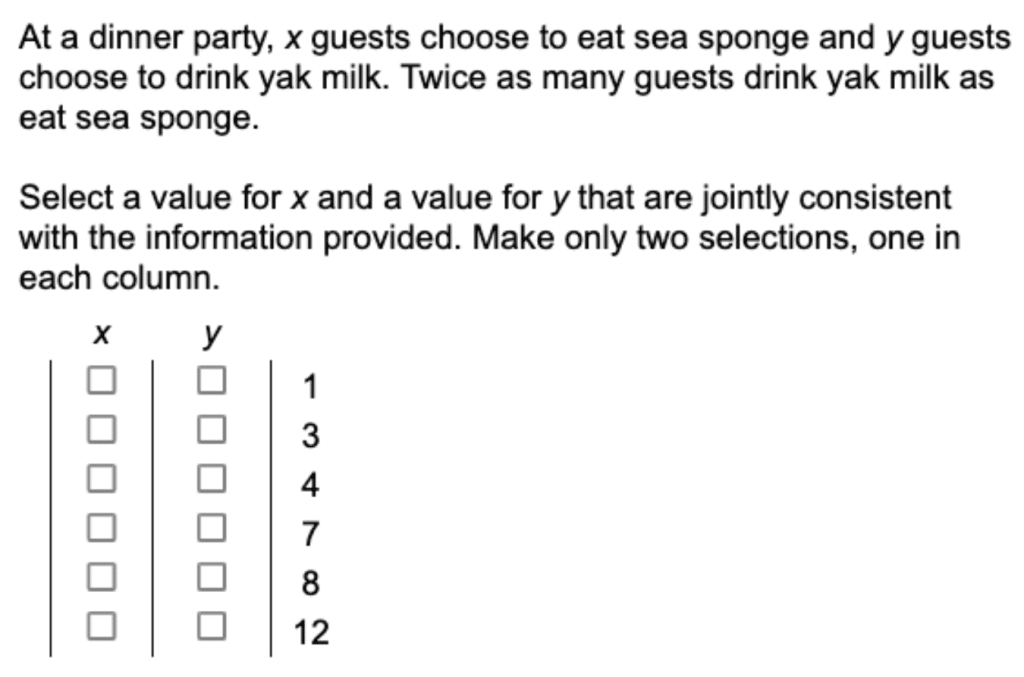
Beginner’s Guide to EA & GMAT Two-Part Analysis Questions
UPDATED FOR THE NEW GMAT IN 2024
GMAT Two-Part Analysis (TPA) questions are multiple-choice problems with a twist: instead of just selecting one answer, you’ll select two answers, one from each of two columns.
One nice thing about Two-Part Analysis questions is that most of them are pretty similar to either GMAT Critical Reasoning or quant word problems. Sure, they introduce a few wrinkles here and there. But by and large, TPA questions test the exact same skills as quant and Critical Reasoning questions. That’s a good thing!
To give you a feel for the format, here’s an example of a GMAT Two-Part Analysis question:

If you’d like to work through a nice variety of verbal-focused and quant-focused Two-Part Analysis questions, check out our videos here:
(A quick note for Executive Assessment test-takers: Two-Part Analysis questions appear on the Integrated Reasoning section of the EA. We’ll refer primarily to the GMAT in this article, but the question format – and our advice for tackling it – is identical for the EA.)
QUANT-BASED GMAT TPA QUESTIONS
WHICH QUANT TOPICS APPEAR ON GMAT TPA QUESTIONS?
Here’s some good news: the quant topics featured in TPA questions are exactly the same as the topics you’ll see on the quant section of the GMAT. So there’s no need to study any additional math in preparation for GMAT Two-Part Analysis questions.
While any GMAT quant topic is fair game for Two-Part Analysis, these topics seem to appear particularly frequently on TPA questions:
- Word problems
- Percentages
- Rates
- Statistics
- Overlapping sets
HOW TO APPROACH QUANT-BASED TPA QUESTIONS
Because quant-based TPA questions are so similar to regular GMAT quant questions, our recommended approach is nearly identical to our advice for the quant section:
- Read carefully. Many students miss GMAT quant questions not because they can’t understand the math, but because they miss a key detail in the question.
- Plot an efficient path forward. There are usually several different ways to solve any quant-based TPA question. If you take a few moments to think through your options before jumping in, you’re more likely to choose an efficient path that avoids tortuous algebra and arithmetic, or endless trial and error – and if you choose an efficient solution path, you’ll have far fewer opportunities to make a score-killing careless error.
- Check your work as you go. Don’t wait until the end of the problem to check your work. By catching careless errors as soon as possible, you’ll make the best use of your precious time and energy.
In addition to this foundational approach to all GMAT quant-based questions, there are a couple of wrinkles to navigate on quant-based TPA.
GUESS AND CHECK WISELY ON GMAT QUANT-BASED TPA QUESTIONS
On a regular GMAT quant question, plugging in answer choices can lead to a correct answer, but it’s very rarely the most efficient way to solve the question. That’s not necessarily the case on quant-based Two-Part Analysis questions.
GMAT TPA questions ask you to select a correct answer in each of two columns. Sometimes, you won’t be able to solve for those two answers individually. Instead, you’ll have to solve for a relationship between the columns. Then, you’ll have to examine both of the columns simultaneously, and pick values that satisfy the relationship.
Here’s what NOT to do: don’t start by randomly testing numbers and hoping that you find a winning combination. TPA questions typically have five or six options for each column, which means that you could have as many as 36 different combinations of answers – so you’re very, very unlikely to blindly guess your way to the right answer.
Instead, push the given information as far as you can. Then, see if you can narrow down the answer choices so that you don’t have to check every possible combination of answers.
To see that in action, think about the example from the beginning of this article:

(Mmm… yak milk. Tastier than you might think!) This is a pretty simple example, but it’s still worthwhile to think through the most efficient solution path.
For this question, the easiest way to deal with the stem information is to create an equation: y = 2x.
What do we know about x and y? Because they represent numbers of guests, they must be integers.
Furthermore, because y is some integer times 2, y must be an EVEN integer.
This significantly reduces the number of answer choices that you have to deal with. Looking at just the even options for y, we can easily see that y must be 8 and x must be 4.
DEALING WITH EXCESS INFORMATION ON QUANT-BASED TPA
Usually, when the GMAT gives you a few pieces of information on a quant question, you’ll need to use all of that information to answer the question. That’s not always the case with TPA questions. Sometimes the prompt deliberately gives you more information than you need.
So if you come across a question that only uses part of the provided info, don’t worry! Just use the facts that you need in order to solve the question.
VERBAL-BASED GMAT TPA QUESTIONS
GMAT TPA QUESTIONS THAT ARE (BASICALLY) CRITICAL REASONING
Many GMAT Two-Part Analysis questions feature a short passage that feels very much like the Critical Reasoning (CR) questions you’ll see on the verbal section of the exam. Critical Reasoning strategies will serve you well on these TPA questions.
GMAT TPA QUESTIONS THAT ARE (BASICALLY) READING COMPREHENSION
Sometimes the passage will be a bit longer, and you won’t be able to keep every detail in your head. If you find yourself in that position, turn to the strategies you use on GMAT Reading Comprehension.
GMAT TPA QUESTIONS THAT FEEL LIKE LOGIC GAMES
Some Two-Part Analysis questions provide a set of rules and then pose a question that asks you to apply those rules. For instance, you could be given six lectures (A, B, C, D, E, and F) to schedule on three days (Monday, Wednesday, and Friday). The rules might specify that Lecture A must happen before Lecture B, Lectures C and D must occur on the same day, and Lecture E must not be scheduled on Friday. The question would then ask you to determine possible schedules for the lectures.
The strategy for tackling these questions revolves around staying organized. Start by carefully reading the problem’s setup and rules, and then sketch out a simple diagram to visually organize the information. This helps you see the relationships and possible configurations at a glance.
Next, take a swing at the questions, using your diagram to eliminate impossible options and zero in on the correct answers.
HOW MANY TWO-PART ANALYSIS QUESTIONS WILL YOU SEE ON THE GMAT?
According to the creators of the GMAT, Two-Part Analysis questions make up 10-20% of the Data Insights section. This means that you’ll see 2-4 TPA questions on the exam. These questions could include any combination of verbal- or quant-based TPA questions.
WANT TO LEARN MORE ABOUT THE GMAT, EA, & DATA INSIGHTS?
- Free, complete video courses for the GMAT and Executive Assessment
- A pile of Executive Assessment and GMAT articles, on all sorts of topics
- Our Data Insights video playlist
- Everything you could possibly want to know about GMAT tutoring
